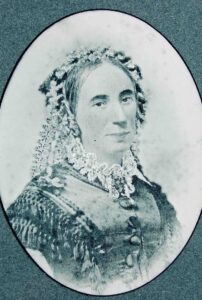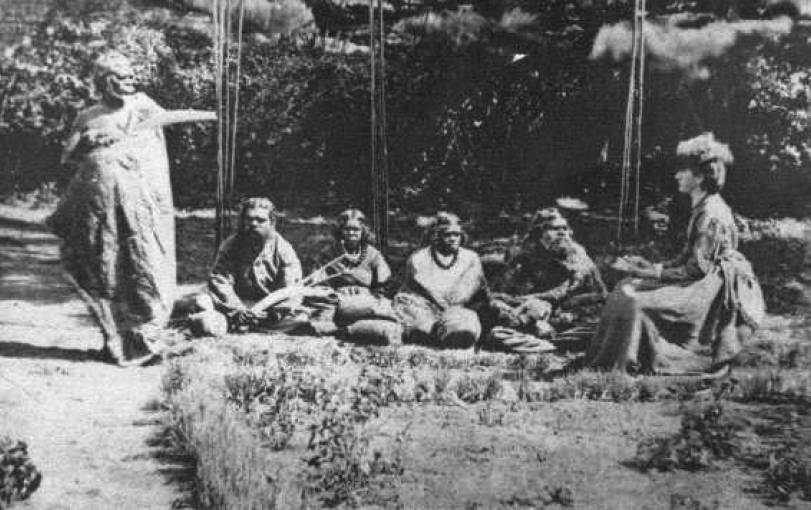Isabella Park (nee Dawson) Taylor (1842 - 1929) Friend of the Aboriginal people. Student of their languages and culture.
 Pictured; Isabella Taylor, c 1870.
Pictured; Isabella Taylor, c 1870.
James Dawson’s name looms large over the colonial history of western Victoria. His daughter Isabella worked closely with him and deserves greater recognition for the outstanding contribution she made to documenting the languages and culture of western Victorian Aboriginal people and for championing their interests.
In November 1839 James and Joan Dawson sailed from Scotland to Australia on the China, arriving at Williamstown in May 1840. A few months later they purchased a small dairy farm on the Yarra River near present day Warrandyte. It was there, in a primitive slab hut, that their only child Isabella Park Dawson was born in 1842.
Selling the dairy farm in 1844, the Dawsons came to the Western District and took up squatter’s rights over ‘Cox’s Heifer Station’, later re-named ‘Kangatong’, in the Hawkesdale area, near Port Fairy.
This was a very formative period in Isabella’s life: At ‘Kangatong’ she was brought up with the local Aboriginal children and became fluent in their languages. It seems Isabella was ‘home schooled’ by her well-educated parents and grew up to be an eloquent, confident and worldly young woman. Importantly, she also adopted her father’s strong commitment to social justice and community responsibility.
James sold his interest in ‘Kangatong’ in 1866 and for the next two years the Dawsons managed a property at Keilor near Melbourne. They moved to the Camperdown area in 1868, where James took up the lease of a property on the south side of Lake Bullen Merri, which he named ‘Wuurong’.
Isabella and her father James shared a deep interest in the Aboriginal people. In her time on her father’s pastoral run at ‘Kangatong’ and subsequently in the Camperdown district, Isabella formed close and abiding relationships with the local Aboriginal people. She was a keen student and recorder of their languages and culture.
Isabella came to public attention in March 1870, when she penned an insightful letter titled ‘The Language of the Aborigines’ to the editor of The Australasian newspaper. It is repeated here in part:
19th March 1870
THE LANGUAGE OF THE ABORIGINES
To the editor of The AustralasianSir,
I request the favour of space in The Australasian to record information about the Aborigines of the Western District of Victoria, which I acquired, during many years of intimacy with the remnants of tribes occupying the country between the Hopkins River and Portland.
My father’s station having always been a favourite place of resort for the blacks and as several of them with their families were generally employed to do work, I had from my infancy better opportunities of acquiring their language and learning their manners and customs than perhaps any other person in the Western District. Such very favourable circumstances having placed me in a position to assist in preserving a knowledge of the Aborigines, were I to neglect doing so I should consider myself not only guilty of gross negligence, but ingratitude to a race of nature’s nobility for which I have the greatest admiration and respect.
People seeing only the miserable remnants of the Aborigines to be met with about public houses may be inclined to sneer at my expressions, but let them come into social communication with them in the bush, away from the means of intoxication, and listen to their artless and innocent conversation, their fun and wit, and they will, nay they must agree with me that they compare most favourably with many people calling themselves civilized.
It may astonish those that are given to consider the Aborigines as a race scarcely human, to be informed that their general intelligence, common sense and shrewdness, are quite equal, if not superior, to that of the poorest classes in Great Britain.
During the many years that I had the most favourable opportunities of studying their nature, I never observed anything dishonest in their conduct or repulsive in their habits and conversation; neither did I observe in their native tongue what may be termed low language, excepting the three instances in the list of ‘vindictive epithets’; but even these solitary cases of idle words would not in our society be considered much out of place. What they may have learned to express in English I do not excuse, excepting on the grounds that they have been taught by a race which assumes a position as far above the poor natives as its practice in many things is beneath them.
Consideration for space in The Australasian prevents further remarks on this interesting subject, and I beg to subscribe myself, yours very respectfully,
Isabella Park Dawson
In her letter, Isabella followed her passionate defence of the Western District Aboriginal people with a list of some 250 English words with their Aboriginal equivalents.
This letter was the stimulus for a landmark book about the Western District Aboriginal people. In the following years Isabella assisted her father James in recording the languages and customs of various dialect groups they came into contact with. They published their research in 1881 under the title The Australian Aborigines: The Languages and Customs of Several Tribes in the Western District of Victoria, Australia. Regrettably, Isabella was not acknowledged as a joint author.
This work remains one of the more valuable insights into Aboriginal life at the point of European contact. The Australian Aborigines, remains one of the most useful tools for reconstructing knowledge of the original languages, cultures and customs of Aboriginal western Victoria.

In April 1877, Isabella married William Andrew Taylor, who had arrived from Scotland the previous year. They built a fine homestead, still standing, on their property ‘Renny Hill’ on the north side of Lake Bullen Merri, near Camperdown. Together they had two children: Effie (born 1878) and Katherine Park (1880).
Isabella remained strongly committed to the welfare of the Aboriginal people. They were frequent and welcome visitors to her home and always remained close to her heart.
This rather touching newspaper clipping c1895 appears in the scrapbook of her father, James Dawson:
Framlingham Blacks
Mr. J.W. Anderson, who is at present on a visit to Warrnambool, has handed to us some interesting photographs of some of the blacks at the Framlingham Aboriginal Reserve, taken at the request of Mrs. W.A. Taylor (Isabella). ‘Renny Hill’, Camperdown. Mrs. Taylor recently paid one of her periodical visits to the station, with little presents to young and old, making quite a red letter day, and gladdening the hearts of the few remaining representatives of the former owners of Australia.
Throughout her long life, Isabella took a keen and active interest in the affairs of the town and district, but was said to be unostentatious in all her activities. She was a staunch member of the Presbyterian Church and together with her husband William, was a foundation member of the Camperdown Horticultural Society. Isabella was a keen supporter of local education and was also a generous donor to the Camperdown Hospital.
Isabella Park Taylor died aged 86 on the 8th August 1929 and is buried at Camperdown. She was a woman ahead of her time.